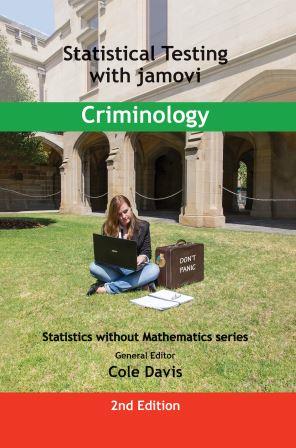|
| Home |
| Order books |

|
Statistical Testing with jamovi for Criminology
Statistical Testing with jamovi for Criminology
Exercises and case studies
Chapter 8 in the book contains basic exercises covering all of Section 2. Diverse tutors, however, have asked for traditional chapter by chapter exercises, hence the table immediately below. Further down the page, case studies are presented for readers who have finished reading the whole book, or their tutors.Exercises
These chapter by chapter exercises have been contributed by Marianne Vitug. For each chapter is a document with the questions, and one with the answers, with relevant spreadsheet files (with the .csv suffix). Each page opens in a new tab of your browser.
| Ch 2 Research design | Questions | Answer | self-entry |
| Ch 3 Descriptive statistics | Questions | Answers | data file 0 |
| Ch 4 Null hypothesis significance testing | Questions | Answers | data file 0 |
| Ch 5 Tests of differences | Questions | Answers | data file 1 |
| Ch 5 Tests of differences | data file 2 | ||
| Ch 5 Tests of differences | data file 3 | ||
| Ch 5 Tests of differences | data file 4 | ||
| Ch 6 Tests of relationships | Questions | Answers | data file |
| Ch 7 Categorical analyses | Questions | Answers | data file |
| Ch 10 Factorial ANOVA | Questions | Answers | data file 1 |
| Ch 10 Factorial ANOVA | data file 2 | ||
| Ch 10 Factorial ANOVA | data file 3 | ||
| Ch 11 ANCOVA | Questions | Answers | data file |
| Ch 12 MANOVA | Questions | Answers | data file |
| Ch 13 PCA and factor analysis | Questions | Answers | data file 1 |
| Ch 13 PCA and factor analysis | data file 2 | ||
| Ch 14 Logistic regression | Questions | Answers | data file |
| Ch 15 Partial correlations | Questions | Answers | data file |
| Ch 17 Bayesian statistics | Questions | Answers | data file |
| Ch 18 Survival analysis (Kaplan-Meier) | Questions | Answers | data file |
| Ch 19 Cluster analysis | Questions | Answers | data file |
Case studies
A range of information can be acquired from the surfaces of telephones, derived from mass spectrometry (Buschman H, 2016, What molecules you leave on your phone reveal about your lifestyle). You are interested in using such measures for criminal profiling.
You are interested in the views of members of the public on trafficked persons. The data has been derived from a large number of questionnaire items.
You have a wealth of quantitative data on attitudes to migrants. You believe that people have specific ideas about the impact of migrants on the labour market, their role in the sex industry and the nature of victimhood.
You have a theory that if there is less time available for bathroom facilities within military prisons, this will increase incidents of prisoners abusing staff with ordure. Other types of incidents, according to your theory, are likely to be caused by other pressures. You believe that age, ethnicity and gender may also affect the classification.
Can different crime patterns around the world be the work of a certain number of crime syndicates? Types of victim and location are likely to affect the classification.
Which characteristics typify different levels of police officer? Include gender and other demographic data as well as measurable attributes.
Do different forms of post-prison rehabilitation have an effect on re-offending, finding work and family functioning?
You are interested in finding out about what causes prison riots. You do not have any usable information except when each incident was reported to have started. It may be interesting to see if the history differs between different types of regime or in different countries. Another focus for enquiry could be the duration of riots, perhaps examining differences between riot control techniques.
Are men or women more likely to be involved in thefts with differing levels of risk of arrest? Which gender is more likely to be involved in high value crimes?
In trying to warn members of the public about 'phishing', the acquisition of electronic information by confidence tricksters, the government at different times uses social media, televised informercials and email campaigns to inform companies and public organisations. Are there different levels of effectiveness and does it make any difference if the content is victim-driven ('this could happen to you') or culprit-based ('don't let him get away with it')?
Students in a state's police academy have over the years found certain statutes on domestic violence to be very difficult to understand. Over the year, two sessions with somewhat different teaching methods are tried: one focuses most on case studies, while one pays more attention to the legal principles involved. The sessions are in fact held four times, so that half the students get to use the case studies first while the other half do legal underpinnings first, each attending the other session later.
Are there particular types of person who carry out Distribution Denial of Service attacks?
(Assume that there is no knowledge of the topic.)
Statistics without Mathematics series - General Editor: Cole Davis
ISBN numbers: Hardback - 978-1-915500-06-9 Paperback - 978-1-915500-07-6
Ebook - 978-1-915500-08-3
